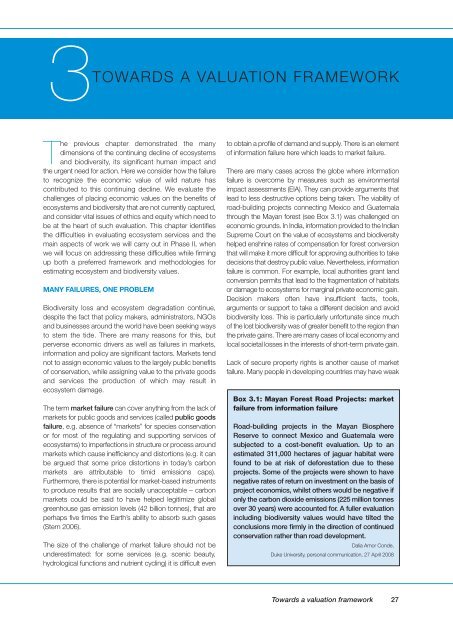Interim Report - TEEB
Interim Report - TEEB
Interim Report - TEEB
You also want an ePaper? Increase the reach of your titles
YUMPU automatically turns print PDFs into web optimized ePapers that Google loves.
3TOWARDS A VALUATION FRAMEWORK<br />
The previous chapter demonstrated the many<br />
dimensions of the continuing decline of ecosystems<br />
and biodiversity, its significant human impact and<br />
the urgent need for action. Here we consider how the failure<br />
to recognize the economic value of wild nature has<br />
contributed to this continuing decline. We evaluate the<br />
challenges of placing economic values on the benefits of<br />
ecosystems and biodiversity that are not currently captured,<br />
and consider vital issues of ethics and equity which need to<br />
be at the heart of such evaluation. This chapter identifies<br />
the difficulties in evaluating ecosystem services and the<br />
main aspects of work we will carry out in Phase II, when<br />
we will focus on addressing these difficulties while firming<br />
up both a preferred framework and methodologies for<br />
estimating ecosystem and biodiversity values.<br />
MANY FAILURES, ONE PROBLEM<br />
Biodiversity loss and ecosystem degradation continue,<br />
despite the fact that policy makers, administrators, NGOs<br />
and businesses around the world have been seeking ways<br />
to stem the tide. There are many reasons for this, but<br />
perverse economic drivers as well as failures in markets,<br />
information and policy are significant factors. Markets tend<br />
not to assign economic values to the largely public benefits<br />
of conservation, while assigning value to the private goods<br />
and services the production of which may result in<br />
ecosystem damage.<br />
The term market failure can cover anything from the lack of<br />
markets for public goods and services (called public goods<br />
failure, e.g. absence of “markets” for species conservation<br />
or for most of the regulating and supporting services of<br />
ecosystems) to imperfections in structure or process around<br />
markets which cause inefficiency and distortions (e.g. it can<br />
be argued that some price distortions in today’s carbon<br />
markets are attributable to timid emissions caps).<br />
Furthermore, there is potential for market-based instruments<br />
to produce results that are socially unacceptable – carbon<br />
markets could be said to have helped legitimize global<br />
greenhouse gas emission levels (42 billion tonnes), that are<br />
perhaps five times the Earth’s ability to absorb such gases<br />
(Stern 2006).<br />
The size of the challenge of market failure should not be<br />
underestimated: for some services (e.g. scenic beauty,<br />
hydrological functions and nutrient cycling) it is difficult even<br />
to obtain a profile of demand and supply. There is an element<br />
of information failure here which leads to market failure.<br />
There are many cases across the globe where information<br />
failure is overcome by measures such as environmental<br />
impact assessments (EIA). They can provide arguments that<br />
lead to less destructive options being taken. The viability of<br />
road-building projects connecting Mexico and Guatemala<br />
through the Mayan forest (see Box 3.1) was challenged on<br />
economic grounds. In India, information provided to the Indian<br />
Supreme Court on the value of ecosystems and biodiversity<br />
helped enshrine rates of compensation for forest conversion<br />
that will make it more difficult for approving authorities to take<br />
decisions that destroy public value. Nevertheless, information<br />
failure is common. For example, local authorities grant land<br />
conversion permits that lead to the fragmentation of habitats<br />
or damage to ecosystems for marginal private economic gain.<br />
Decision makers often have insufficient facts, tools,<br />
arguments or support to take a different decision and avoid<br />
biodiversity loss. This is particularly unfortunate since much<br />
of the lost biodiversity was of greater benefit to the region than<br />
the private gains. There are many cases of local economy and<br />
local societal losses in the interests of short-term private gain.<br />
Lack of secure property rights is another cause of market<br />
failure. Many people in developing countries may have weak<br />
Box 3.1: Mayan Forest Road Projects: market<br />
failure from information failure<br />
Road-building projects in the Mayan Biosphere<br />
Reserve to connect Mexico and Guatemala were<br />
subjected to a cost-benefit evaluation. Up to an<br />
estimated 311,000 hectares of jaguar habitat were<br />
found to be at risk of deforestation due to these<br />
projects. Some of the projects were shown to have<br />
negative rates of return on investment on the basis of<br />
project economics, whilst others would be negative if<br />
only the carbon dioxide emissions (225 million tonnes<br />
over 30 years) were accounted for. A fuller evaluation<br />
including biodiversity values would have tilted the<br />
conclusions more firmly in the direction of continued<br />
conservation rather than road development.<br />
Dalia Amor Conde,<br />
Duke University, personal communication, 27 April 2008<br />
Towards a valuation framework<br />
27

















